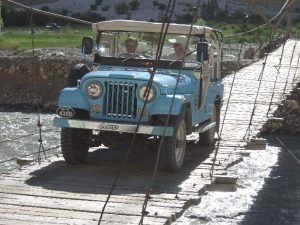 The Deosai plateau, covering an area of over 400 sq.kms, all of it is above 4000m is uniquely beautiful region. In China, the word translates literally as ‘giants bode’, and it isn’t hard to see how a landscape of such a massive scale could have inspired stories of giants. In local language (Balti), the region is known as Bhear Sar, meaning ‘place of flowers’, an apt description during summer.
The Deosai plateau, covering an area of over 400 sq.kms, all of it is above 4000m is uniquely beautiful region. In China, the word translates literally as ‘giants bode’, and it isn’t hard to see how a landscape of such a massive scale could have inspired stories of giants. In local language (Balti), the region is known as Bhear Sar, meaning ‘place of flowers’, an apt description during summer.
The Deosai is at its best from mid July to end of September. While the weather can be glorious in daytime during this period, temperature drop dramatically ay night, and can also turn nasty very quickly, which intense windstorms often sweeping across the plateau. The plateau is home to the Himalayan Brown Bear (Ursus arctos Isabellinus), a species of bear unique to this part of the world. Other mammals include the Golden Marmot (in large numbers), Tibetan Wolf, Tibetan Red Fox, Himalayan Ibex, Ladakh Urial and various small rodents, including voles and shrews.
Reptiles include lizards such as the Himalan Agma, Ground Skink and Glacial Skink. The unique snow carp is found in the Deosai rivers. This region also home to some Snow Leopards and Musk Deer particularly among birch and juniper forests. The recently discovered Alpine Toad looks set to qualify as a separate species.
 The plateau provides spring and summer breeding grounds for many of Pakistanis birds, including the Himalayan Golden Eagle, Lammergier (bearded vulture), northern Hobby (a falcon), Kestrel and Long-legged Buzzard, as well as larks, wagtails, warblers and sand plovers. It also lies on the flight path a number of migratory birds which can be seen from late September to mid October on their return from centralAsiato the plains of subcontinent. Species include the Osprey, Damoselle Crane, Little Trunk, Great Black-headed Gull and ducks such as the common Teal, Pintail, Shoveller and Marganzer. More than 40 spices of plans and grasses are found on the Deosai, including colourful flowers such as Aconitum, Rheum, Iris, Astragalus ad Spiraea. There is also wealth of herbs and medicinal plants, including Ginger, Primula, Geranium, Mint, Artmesia, Rubus and Barberry. At lower altitude on the peripheries wild rose is found, as well as trees such as Juniper, Blue Pines, Spruce, Penciul Cedar, White Birch, Himalayan Poplar and Chinese Salix.
The plateau provides spring and summer breeding grounds for many of Pakistanis birds, including the Himalayan Golden Eagle, Lammergier (bearded vulture), northern Hobby (a falcon), Kestrel and Long-legged Buzzard, as well as larks, wagtails, warblers and sand plovers. It also lies on the flight path a number of migratory birds which can be seen from late September to mid October on their return from centralAsiato the plains of subcontinent. Species include the Osprey, Damoselle Crane, Little Trunk, Great Black-headed Gull and ducks such as the common Teal, Pintail, Shoveller and Marganzer. More than 40 spices of plans and grasses are found on the Deosai, including colourful flowers such as Aconitum, Rheum, Iris, Astragalus ad Spiraea. There is also wealth of herbs and medicinal plants, including Ginger, Primula, Geranium, Mint, Artmesia, Rubus and Barberry. At lower altitude on the peripheries wild rose is found, as well as trees such as Juniper, Blue Pines, Spruce, Penciul Cedar, White Birch, Himalayan Poplar and Chinese Salix.
ITINERARY
Day 01: Arrival at Islamabad international airport, transfer to hotel for overnight stay.
Day 02: A pleasant drive to Shogran in beautiful Kaghan Valley at 2400m.
Day 03: To Naran the centre of Kaghan Valey and superb place for hikes and fishing.
Day 04: Day free for fishing and visit to the legendary lake Saiful Maluk at 3212m.
Day 05: A spectacular ascend on jeeps to Babusar Pass(4173m) provides views of whole Kaghan Panorama. Drive steep down hill for 50kms to Chilas.
Day 06: Across KKH and Indus River through Astore gorge to beautiful Rama at (3480m.
Day 07: Descend to Astor and continue to Chilum at the foot of Deosai Plateau.
Day 08: Today’s drive will be a life-time memory of driving through a treeless wilderness at 4000m, knee deep in summer grass with beautiful wild flowers, whistling marmots and grazing yaks. Descend down through narrow Satpara gorge to the deep blue Satpara Lake.
Day 09: Day free for local visit or walking on sand dunes of Skardu and local bazaars.
Day 10: Full day excursion to Talish Village in Hushe Vallay to view Amazing Masherbrum Peak.
Day 11: An adventurous 10-11 hours drive to Chilas with magnificent panorama of the mightyIndusRiver, squeezed between high cliffs of the Haramosh and Rakaposhi ranges fighting its way through deep gorges.
Day 12: Drive back to Islamabad route visiting Taxila Ruins.
Day 13: Fly Back Transfer to airport to embark home flight.
End of services.

